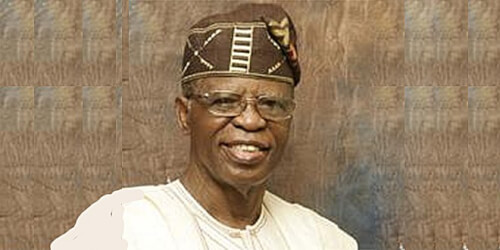Joseph Oladele Sanusi was born on 24 September 1938 in Ogbagi-Akoko, Ondo State, Nigeria. He studied at South West London College and Kingston College of Technology, England from 1962 to 1965, qualifying as a Chartered Accountant. He became a member of the Institute of Chartered Accountants of Nigeria (ICAN) in 1969 and became a fellow of the Nigerian Institute of Bankers in 1987.
Read more about Men you should know
Career
Sanusi worked first as an Accountant in England, then with the Department of Customs and Excise in Nigeria. He joined the Central Bank of Nigeria (CBN) in 1966 as a Deputy Manager. He became a Departmental Director in 1977, Chief Executive of the Securities and Exchange Commission (1978–1979), Executive Director, Monetary and Banking Policy (1979–1984), and Deputy Governor (1988–1990). Sanusi left the CBN to become managing director and Chief Executive of the United Bank for Africa (1990–1992), then managing director and Chief Executive of First Bank of Nigeria (1992–1998). He was also Vice-Chairman of Nigeria Merchant Bank and Chairman of Banque Internationale du Benin.
Governor of the Central Bank
In May 1999 Sanusi was appointed Governor of the Central Bank of Nigeria by President Olusegun Obasanjo, serving until May 2004. Sanusi was picked as a safe and conservative banker. He quickly introduced foreign exchange controls in an effort to reduce the drain on foreign reserves which had fallen from over $7 billion to under $4 billion in the last two years, and to defend the Nigerian naira. Oil revenues, the primary source of foreign exchange, had dropped below the level needed to cover basic requirements. The business community was hostile to the efforts to prop up the currency, believing that devaluation coupled with exchange market reform was necessary.
Noteworthy Contributions at the Central Bank
The Central Bank made remarkable progress under his leadership, some of which are the following:
- The external reserve rose from $4.98bn in May 1999 to $10.08bn in May 2004.
- Project EAGLES was established with the aim to refocus the CBN, post-military era, and develop a strategy for achieving the statutory mandate of the Bank by restructuring to change its operating philosophy and business processes.
- Full deregulation under the Inter-Bank Foreign Exchange Market (IFEM). IFEM was introduced in October 1999.
- The Retail Dutch Auction System, (rDAS) was re-introduced in 2002 following the failure of the old mechanisms of exchange rate determination that had been implemented to achieve the specified objectives. The system enhanced professionalism in the conduct of the foreign exchange market.
- The Nigerian Automated Clearing System (NACS) became operational in October 2002. Clearing cycles for up-country, Intra-country and local instruments were shortened considerably. The intra-state instrument was abolished in 2003 and the cycle for local cheques became T+2.
- A new settlement framework was developed in April 2004 categorising banks into settlement and non-settlement banks. This reduced the Bank’s exposure and the use of high powered money, which is inflationary. It also instilled market discipline in participants within the payments system.
- Guidelines on e-banking were developed and issued in 2003. This formed the foundation for the CBN promotion and regulation of electronic payments.
Sign up to the Connect Nigeria daily newsletter
- Adoption of Universal Banking in 2001 due to the need to provide a level-playing field for banks and the desire to strengthen their capacity to fund commercial and industrial activities, through the diversification of their product and services.
- Debt Management Office (DMO) was incubated by the CBN in 2002 for the purpose of providing a one-stop-shop for clearing all Nigerian Government debts at all levels.
- West African Monetary Institute (WAMI) was introduced in 2001 as an interim institution with the goal of monitoring the macroeconomic performance of the member countries and submission of the reports periodically to the convergence Council of Ministers and Governors.
- Bank of Industry (BoI) was inaugurated in May 2002 with the core mandate of accelerating the pace of industrial growth with a view to promoting national economic development.
- Abuja Securities and Commodities Exchange (ASCE) came into being through the conversion of the Abuja Stock Exchange (ASE) in 2001.
- Trust Form Model (TFM) was introduced in 2001 as a strategy for reducing the exposure of banks that granted uncollateralised agricultural loans to small scale farmers, as well as facilitating their access to credit.
- The Interest Drawback Programme (IDP) was introduced in 2003 to reduce the effective borrowing rate under the ACGS, without the complication of introducing dual interest rates.
Sanusi should also be credited with the banking sector initiative in financing the Small and Medium Scale Enterprises (SME). He led the banking sector delegation (as part of the Presidential Team) to Singapore and Indonesia in 2003 mainly to study how the Asian Tigers had been able to support the SMEs to power the impressive growth recorded in this region in the past decades. The trip was an eye-opener and soon afterwards, the Bankers’ Committee established the popular Small and Medium Enterprises Equity Investment Scheme (SMEEIS) which has gone a long way in supporting Nigeria’s SME, a feat still being sustained by the Central Bank of Nigeria and the Bankers’ Committee today.
Later Career
On 7 October 2004, he was appointed to the board of directors of Lafarge Cement Wapco, a cement manufacturing company in Nigeria owned by Lafarge of Paris. Other post-CBN appointments include Chairman of Standard Chartered Bank Nigeria, First Pension Funds Custodian, Santrust Securities, STI Consulting and Global Biofuels, and Director of West African Portland Cement and Marina Foods.
In 2002, Sanusi was awarded the rank of Commander of the Order of the Niger (CON). In May 2004, Sanusi voluntarily retired and handed over to Charles Chukwuma Soludo.
Sources:
Joseph Oladele Sanusi (2001). The Nigerian economy: growth, productivity and the role of monetary policy. Development Policy Centre.
Dawn Commission
Wikipedia
Featured Image Source: Dawn Commission
Got a suggestion? Contact us: [email protected]

